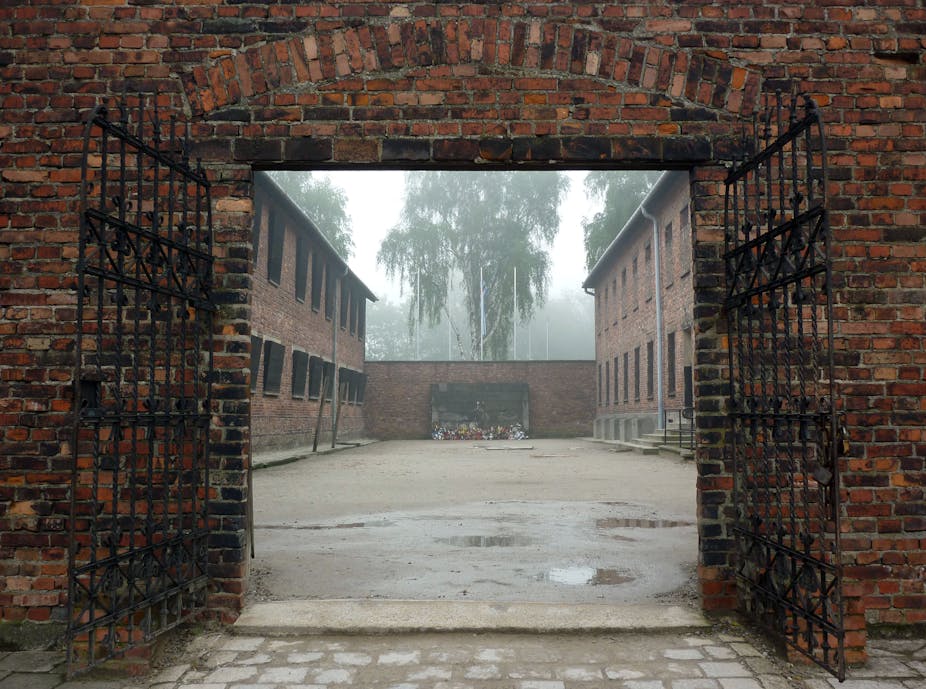Ouch. I think my entire body physically cringed when I came across the latest story of a misjudged tweet gone viral this week: the case of Breanna Mitchell, the naïve teenager and self-styled “Princess” who posted a selfie of herself smiling at Auschwitz concentration camp.

In the tweet we see a carefully framed photograph in the middle of the street, with obvious attention taken to put the buildings at the back into the correct perspective, full marks too for the application of the rule of thirds.
But … what could be more universally damning than a narcissistic selfie at a place notorious for genocide? And worse, an accompanying emoticon of a smugly grinning, blushing smiley face. What was the girl thinking? Let’s try to work it out.
Selfie v solemnity
To me, this story highlights what seems to be a case of total confusion between two very different cultural codes:
1) How you are supposed to represent yourself in a self-taken shot – which is typically coded through tropes of humour as it is disseminated through social media networks
2) The behavioural codes and appropriate respectful displays of affect while visiting a tragically-marked tourist and memorial site of recent history.
It appears this young teenager has been aware of the first code while failing to comprehend the full implications of the second.
Tragic destinations
Travel to tragic locations – otherwise called “death tourism” – is a unique form of holidaying in the contemporary world.

In general, contemporary tourism is usually understood to be an enjoyable undertaking – whether it is hedonistic, adventurous, restorative or educational. After all, to travel to an international destination usually represents a considerable investment for the traveller. Surely, at some level, you actually want to go to the destinations you choose?
For the cruel death districts of ancient times – such as the Roman Colosseum – it is of course completely acceptable today to leer into the camera and joke around the site. The distance of time has softened the blow, and we can disconnect our sense of personal culpability from the acts of what seems an alien civilisation.
But death tourism to places of recent history – when survivors and close relatives are still living – is different. Like contemporary versions of the religious pilgrimage, they are places that we as a society believe invite introspection about the crimes of humanity. These are sacred spaces.
The pleasure of tourism
The existence of death tourism means there are morbid travel zones that nonetheless bring a kind of pleasure to the visitor. What kind of pleasure could one experience at Auschwitz, of all places? Maybe the indulgence of a morbid, and taboo, sense of curiosity, for starters.
The site as a memorial and museum (which opened to visitors from 1947) exists only for certain kinds of pleasure: the noble pursuit of knowledge, of understanding, and the desire to pay respect to the dead.
Those who forget the past are condemned to repeat it. Visiting this site comes with a commitment and a pledge that you will act to not allow such heinous crimes to happen again. It is an ethical place that requests you to mourn, learn and think.
The website for Auschwitz warns “visitors should behave with the appropriate solemnity and respect” while at the site, although it does not outline exactly how the visitor should behave.
Hence the outrage about a girl’s selfie – which in our current culture also has connotations of self-interested PR, wannabe celebrity culture and extremely poor taste.
To add to the denouncement of the selfie, in the last week the American parody singer Weird Al Yankovic released a song called Tacky – a track that included the lyric that a person with bad taste would “live-tweet a funeral, take selfies with the deceased”.
To smile in a photograph at Auschwitz suggests a complete disregard for appropriate solemnity.
Susan Sontag in her brilliant 1977 text On Photography – written decades before the invention of the digital selfie – suggests that taking a photograph is a way of both certifying but also refusing an experience, “by limiting experience to a search for the photogenic, by converting experience into an image, a souvenir.”
Yet the collection of a photo as a souvenir, which comes from the word “memory”, can also be seen as a deeply personal act, a way of converting a remembrance into an object that one can return to and cherish.
Despite how cringe-worthy this incident may seem at first glance, perhaps we need to consider the option that this teenager was recording and uploading this photograph as an act of personal introspection.
We could think of it as a form of memory that she would be able to hold on to, as a form of insurance so that she would not forget her experience.
For many people, Twitter, Instagram, Flickr, etc have become the repositories to keep such personal photographs – they have become our modern photo albums. The question we face today is how to rectify personal photo taking and the accumulation of these “online souvenirs” with the extremely public dissemination of these images – something Breanna Mitchell is no doubt thinking over too.

